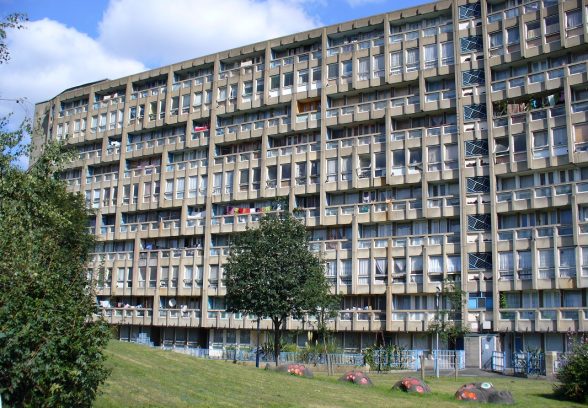This website uses cookies
This website uses cookies to enable it to function properly and to analyse how the website is used. Please click 'Close' to accept and continue using the website.



The future of Robin Hood Gardens looks increasingly bleak, following today’s announcement by Historic England that Heritage minister Tracey Crouch is due not to list the east London estate.
The government is set to issue a second certificate of immunity from listing – which prevents any further applications to list for the next five years. This follows the expiration of the first five year Certificate of Immunity, which had expired, allowing the case to be considered afresh.
We deeply the regret the fact that Historic England (previously English Heritage) once again recommended that the housing estate should not be listed – despite the Twentieth Century Society presenting an extremely strong case, and a last minute rallying of support from leading architects and academics, organised by Lord Richard Rogers .
Catherine Croft, Director of Twentieth Century Society said: “We are deeply disappointed that despite our best endeavours to save the buildings, and to show it had a viable future, and the intervention of Lord Rogers and the support of many eminent architects, the government has once again decided not to list Robin Hood Gardens.
This historic development, designed by two of most influential and important twentieth century architects in Britain, should be kept for future generations and imaginatively refurbished – not demolished. Much has changed in terms of attitudes to post war housing since Tower Hamlets first proposed demolishing Robin Hood Gardens.
Listing would have allowed fresh analysis in the light of these changes. Not only is the architectural and historic value of buildings like Robin Hood Gardens now better understood, but there is more appreciation of the value of maintaining established communities and better skills for successful upgrading and refurbishment. The backlash against the demolition of the Heygate Estate at Elephant and Castle, and the public revulsion at the bland new high rises going up on that site should have taught us not to repeat the same mistake.
We have issued a Freedom of Information Request to understand how the decision making process was made, and to see what expertise they have drawn upon to arrive at this decision.”
The 1972 housing complex is a key work by Brutalist architects Alison and Peter Smithson. It is modelled on the “streets in the sky” concept and is made up of two concrete slab blocks arranged around a landscaped setting of raised mounds. Comprising 213 flats, the complex was first threatened with demolition in 2008 when Tower Hamlets council announced the redevelopment of the site – adjacent to Blackwall Tunnel.
The Twentieth Century Society requested a formal review of the decision not to list in 2008, but in 2009 DCMS re-instated their view and a Certificate of Immunity from listing was issued for the subsequent five years. We then challenged the new further five year period of immunity from listing which Tower Hamlets Council applied for in 2014.
The re-development of Robin Hoods Gardens comprises the second phase of the 1,575 home Blackwall Reach regeneration project, masterplanned by Aedas.
Our campaign to save the complex was supported by a raft of high profile and international architects including Renzo Piano, Moshe Safdie, Lord Rogers, Zaha Hadid, Jean Nouvel, Frank Gehry, Rafael Viñoly, Ted Cullinan, Will Alsop, Amanda Levete and RIBA president Stephen Hodder.

Become a C20 member today and help save our modern design heritage.